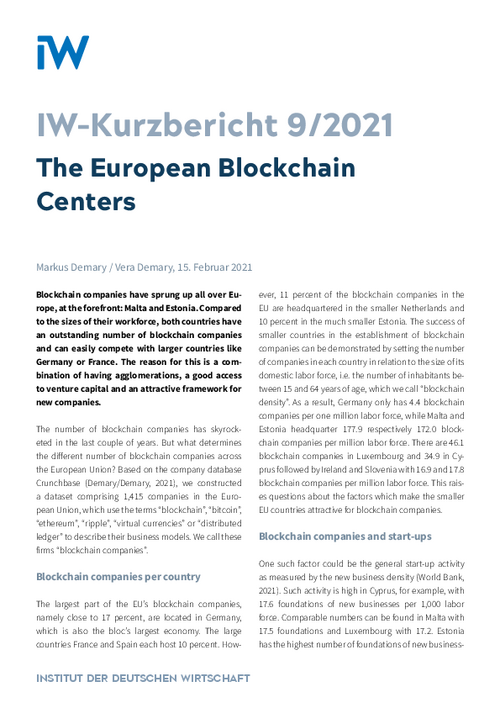Blockchain companies have sprung up all over Europe, at the forefront: Malta and Estonia. Compared to the sizes of their workforce, both countries have an outstanding number of blockchain companies and can easily compete with larger countries like Germany or France. The reason for this is a combination of having agglomerations, a good access to venture capital and an attractive framework for new companies.

The European Blockchain Centers
IW-Kurzbericht

Blockchain companies have sprung up all over Europe, at the forefront: Malta and Estonia. Compared to the sizes of their workforce, both countries have an outstanding number of blockchain companies and can easily compete with larger countries like Germany or France. The reason for this is a combination of having agglomerations, a good access to venture capital and an attractive framework for new companies.
The number of blockchain companies has skyrock- eted in the last couple of years. But what determines the different number of blockchain companies across the European Union? Based on the company database Crunchbase (Demary/Demary, 2021), we constructed a dataset comprising 1,415 companies in the Euro-pean Union, which use the terms “blockchain”, “bitcoin”, “ethereum”, “ripple”, “virtual currencies” or “distributed ledger” to describe their business models. We call these firms “blockchain companies”.
Blockchain companies per country
The largest part of the EU’s blockchain companies, namely close to 17 percent, are located in Germany, which is also the bloc’s largest economy. The large countries France and Spain each host 10 percent. How-ever, 11 percent of the blockchain companies in the EU are headquartered in the smaller Netherlands and 10 percent in the much smaller Estonia. The success of smaller countries in the establishment of blockchain companies can be demonstrated by setting the number of companies in each country in relation to the size of its domestic labor force, i.e. the number of inhabitants be-tween 15 and 64 years of age, which we call “blockchain density”. As a result, Germany only has 4.4 blockchain companies per one million labor force, while Malta and Estonia headquarter 177.9 respectively 172.0 blockchain companies per million labor force. There are 46.1 blockchain companies in Luxembourg and 34.9 in Cy- prus followed by Ireland and Slovenia with 16.9 and 17.8 blockchain companies per million labor force. This rais- es questions about the factors which make the smaller EU countries attractive for blockchain companies.
Blockchain companies and start-ups
One such factor could be the general start-up activity as measured by the new business density (World Bank, 2021). Such activity is high in Cyprus, for example, with 17.6 foundations of new businesses per 1,000 labor force. Comparable numbers can be found in Malta with 17.5 foundations and Luxembourg with 17.2. Estonia has the highest number of foundations of new business-es in the EU, which is related to its business-friendly regulation and the possibility to start a company fully digitally (e-estonia, 2021). Ireland and the Netherlands also have relatively high numbers of foundations of new businesses with 7.1 and 6.4 per 1,000 labor force. The correlation coefficient between start-up activity and the number of blockchain companies is 0.79. This is quite high and can be mainly explained by the fact that most blockchain companies are start-ups: Around 60 percent of these companies in the EU are less than 5 years old; 31 percent are between 6 and 10 years old.

Markus Demary / Vera Demary: The European Blockchain Centers
IW-Kurzbericht

More on the topic
Not so Different?: Dependency of the German and Italian Industry on China Intermediate Inputs
On average the German and Italian industry display a very similar intermediate input dependence on China, whether accounting for domestic inputs or not.
IW
China’s Trade Surplus – Implications for the World and for Europe
China’s merchandise trade surplus has reached an all-time high and is likely to rise further. A key driver appears to be a policy push to further bolster Chinese domestic manufacturing production, implying the danger of significant overcapacities.
IW